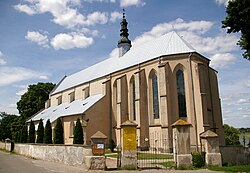Bodzentyn
| Bodzentyn | ||
|---|---|---|

Parish church
|
||
|
||
| Coordinates: 50°56′27″N 20°57′28″E / 50.94083°N 20.95778°E | ||
| Country |
|
|
| Voivodeship | Świętokrzyskie | |
| County | Kielce | |
| Gmina | Bodzentyn | |
| Area | ||
| • Total | 8.65 km2 (3.34 sq mi) | |
| Population (2006) | ||
| • Total | 2,241 | |
| • Density | 260/km2 (670/sq mi) | |
| Postal code | 26-010 | |
| Car plares | TKI | |
| Website | http://www.bodzentyn.pl | |
Bodzentyn [bɔˈd͡zɛntɨn] is a town in Kielce County, Świętokrzyskie Voivodeship, Poland, with 2,271 inhabitants (2004). Bodzentyn Castle was built in the 14th century. Bodzentyn belongs to Lesser Poland, and was granted town charter in 1355. The town lies in the Świętokrzyskie Mountains, here main office of the Świętokrzyski National Park is located.
Bodzentyn (or Bodzentin, as it used to be called in documents) was founded in 1355 near the location of the ancient town of Tarczek, which belonged to the bishops of Kraków. Its charter was granted by King Kazimierz Wielki; the name of the town comes from bishop of Kraków, Jan Bodzanta. Bodzentyn was the center of land properties (see herrschaft) of the bishops of Kraków. In 1365 bishop Florian from Mokrsko built here a castle, and surrounded the town with defensive walls. In 1380 bishop Jan Radlica founded Holy Cross church, and in the late Middle Ages, Bodzentyn was one of the most important urban centers of northern Lesser Poland. In 1410 King Władysław Jagiełło spent a few days here, on his way to the Battle of Grunwald. Soon afterwards, the town burned in a fire, so bishop Wojciech Jastrzębiec managed to convince the king to grant new privileges to Bodzentyn. Another bishop who contributed to the development of the town was Piotr Wysz Radoliński. He granted Bodzentyn’s residents the rights to cut down forests, graze cattle, sell salt, meats and liquors. Furthermore, a marketplace was established. In 1450, Cardinal Zbigniew Oleśnicki founded here a Gothic collegiate church.
...
Wikipedia


